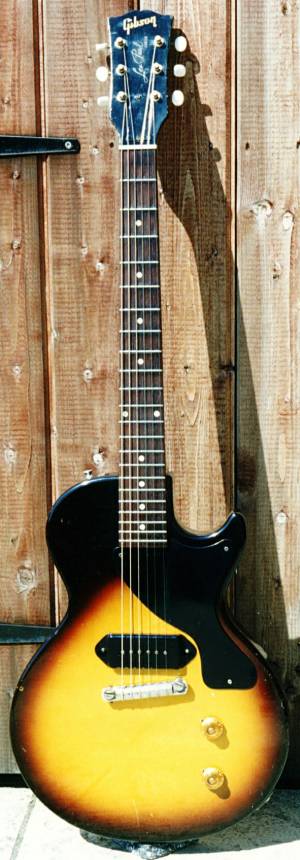
The success of the Les Paul model in the early 'fifties prompted Gibson to expand the range further, with the introduction, in 1954, of the high-end Custom - the all-mahogany, gold-plated "Black Beauty" - and the Junior, a stripped-down budget guitar aimed at beginners and students. The Junior retained the 1¾" thick mahogany body, but not the carved maple top, and was equipped with a single P.90 pick-up and stud wrap-over bridge. Its one-piece mahogany neck had no fancy edge binding, and the tuners were three-on-a-strip Klusons with plastic buttons. Retailing at $99.50, the new baby was an instant favourite.
By 1958, sales had been overtaken by rival products from Gretsch and Fender, forcing Gibson to re-think the design. The new double-cutaway models were finished in a rich cherry colour, and though they had a slightly brighter sound, they lacked the fashionable twang of their competitors, and by 1960 production ceased altogether. For a decade they languished in thrift shops and garages and under beds, changing hands for peanuts whilst their up-market brethren enjoyed worthy reputations, thanks to the patronage of Eric Clapton, Jeff Beck, Peter Green et al in the blues boom of the late 'sixties. Who wanted a guitar with one pick-up on it, anyway?
In 1970, New York rockers Mountain released their debut album. On hearing Leslie West's yearning solos in "Theme For An Imaginary Western", I was drawn immediately to the tone of the guitar. Huge it was, yet sweet and delicate, like some pirouetting dinosaur singing a rhapsody. The rhythm tracks were massive chunks of buzz-saws and motor-cycles, yet satisfyingly musical nonetheless. The little Junior had at last found its real voice, West's influence going on to define the essence of heavy rock guitar in the 'seventies. You just know Brian May was listening!
I'm going on record here as saying that the 'fifties Les Paul Junior is the best-sounding electric guitar ever made. Fender buffs may choose to disagree, yet the marriage of its mahogany body and neck, sturdy and rigid string anchor and beefy single-coil pick-up provide the ideal physical properties necessary for the most efficient transmission of a vibrating steel string.
The most important element of the sound is the wood itself. Where did this timber come from? Why is there no more of it? Even Gibson themselves don't know! Their current $10,000 Standard 59 Flametop Reissue Aged is virtually indistinguishable from the $75,000 original, to the untrained eye - yet despite the sternest efforts of the company's craftsmen, that magical sound still evades them.
A 1950's Les Paul Junior will cost you considerably less than ten grand, but you'll get a million-dollar sound no other guitar can offer. There are thousands of them out there, and I've never played a bad one, though I have had mine re-fretted as the original frets were very low. The tuners are original but the plastic buttons perished, so have been replaced. The two-tone sunburst finish, which must have looked old-fashioned even in the 'fifties, has mellowed to resemble an egg-yolk frying in burnt fat. Lovely! As for the sound, it has that unmistakable cello-like timbre, with power and sustain to spare. With a signal this pure, it can be shaped and moulded into many applications. Just back the volume control down a notch for a clean rhythm sound, the tone is still there. Caveat emptor - do not pay top dollar if the wrap-over bridge is missing. Vital to the sound, many of these were replaced during the seventies by the dreaded Leo Quan Badass (or, the Leo Quan sustain remover, as I've learned to my cost). Replacement tuners we can forgive - those Klusons look nice, but aren't much cop - but we won't be replacing the P.90 with a humbucker, no sir.
Good luck, tone seekers everywhere!
Recording debut:
Steve Hogarth: You Dinosaur Thing (solo), summer 1996.
Features on: Steve Hogarth's "Ice Cream Genius" sessions, 1996; home recordings a-plenty.